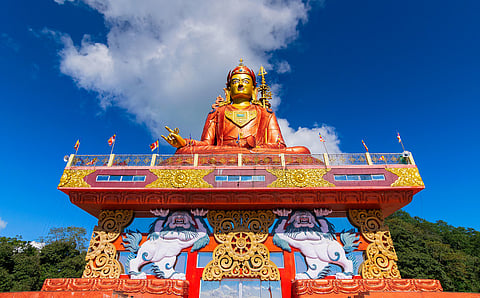

The Supreme Court on December 18 directed the state of Rajasthan as well as the Government of India to protect their sacred groves, in what is being seen as a landmark ruling on the country’s ecological wealth and heritage.
“The court deems it necessary to propose certain suggestions to promote the sustainable conservation of sacred groves and empower the communities associated with their protection,” the judgement by a bench of Justices BR Gavai, SVN Bhatti and Sandeep Mehta, noted.
But long before December 18, India had seen protests, agitations and litigation centred on something similar: That nature and biodiversity are intrinsic to the identity and lives of the country’s indigenous peoples and local communities.
Two of the most important among them were centred in the Northeast and eastern parts of the country.
One was the Rathong Chu agitation, which was spearheaded by the Lepchas and Bhutias, the indigenous people of Sikkim, a state that became part of the Union of India only in 1975.
The agitation began as an anti-dam movement between 1995 and 1997 in the state’s West District against the 30 MW Rathong Chu HEP.
The project was envisioned by the new Sikkim Democratic Front government of the state under Chief Minister Pawan Chamling. It sought to construct a hyder power dam on the Rathong Chu, a river considered sacred by the Buddhist Lepchas and Bhutias. The water of the river was and is used in the Bum Chu ritual in the Tashiding Monastery, a tradition harking back to the time when Sikkim was an independent monarchy under the Chogyal rulers.
“Rathong Chu HEP was eventually scrapped in 1997 under intense public pressure by the SDF party leader, the then Chief Minister of Sikkim, Mr. P.K. Chamling, causing “a major setback” to the power situation of the State. However, Mr. Chamling was hailed as an instant “hero of the masses”, and two years after, the SDF party registered its second major victory in the 2009 State Assembly election, securing Mr. Chamling’s second term as the Chief Minister of Sikkim,” Rinchu Doma Dukpa, Jaime Hoogesteger, Gert Jan Veldwisch and Rutgerd Boelens note in their 2024 paper Hydropower Politics in Northeast India: Dam Development Contestations, Electoral Politics and Power Reconfigurations in Sikkim.
They add that the announcement of 29 additional dams for Sikkim in 2003 by the Centre as a part of its 50,000 MW Hydel Initiative for the country triggered a second wave of anti-dam protests in Dzongu, resulting in the formation of a new Lepcha civil society organisation, the Affected Citizens of Teesta (ACT), in 2004 to protest against all the dam projects in North Sikkim.
The high point came between 2007 and 2010, when the ACT took their protest to the state capital Gangtok.
“Unlike other, more prominent anti-dam movements of India that were mobilised around key issues of displacement and rehabilitation, ACT’s anti-dam movement in Gangtok was overtly focused on geo-ethnic underpinnings. It heavily relied on Lepcha “folklore and mythology” to establish the Lepchas of Dzongu “as protectors of a scared place”, easily appealing to the imageries of the common masses,” Dukpa, Hoogesteger, Veldwisch and Boelens write.
As Maya Mirchandani wrote in The Teesta water dispute: Geopolitics, myth and economics, “For the Sikkimese, in the hills, dharma (belief, faith, and duty) and folklore go hand in hand with economics. The Sikkimese connect with nature in fundamental, intrinsic ways. Their relationship with water is simple and symbiotic. To them, it is a free public good, freely available.”
A few years later, another similar landmark case caught the attention of the entire country.
As Richard Mahapatra of Down To Earth reported, on April 18, the Supreme Court ordered that the village councils in Odisha’s Rayagada and Kalahandi districts would decide whether their right to worship is violated by projects of mining and metals giant Vedanta.
The court in no uncertain terms upheld the tribals' right to worship.
The famous Niyamgiri case centred around Vedanta wanting to mine bauxite from the Niyamgiri hills. The Dongria Kondhs, a Scheduled Tribe, treat these hills as their god, or Niyam Raja.
“Needless to say, if the bauxite mining project, in any way, affects their religious rights, especially their right to worship their deity, known as Niyam Raja, in the hills top of the Niyamgiri range of hills, that right has to be preserved and protected,” the apex court ruled.
The apex court upheld two major rights: the constitutional right of tribals to their own way of life and the right of the community through village councils to decide on affairs that may negatively impact their lives.
“Religious freedom guaranteed to scheduled tribes and the forest dwellers under Articles 25 and 26 of the Constitution is intended to be a guide to a community of life and social demands. The above mentioned Articles guarantee them the right to practice and propagate not only matters of faith or belief, but all those rituals and observations which are regarded as integral part of their religion. Their right to worship the deity Niyam-Raja has, therefore, to be protected and preserved,” the Supreme Court ruled in the Vedanta order dated April 18, 2013.